QuestionQUESTION: I adopted a young male (uncastrated) street dog abroad about 4 weeks ago (2 of which in the holiday home in Montenegro). It seems he is Tibetan Spaniel, docked, and besides many ticks and knots has no fear of people or dogs and is very loving and playful.
He is about 2,5 years old and has now been with us (or at least me - the other 3 of the original holidayn party are less present is daily routine) in the Netherlands for about 2 weeks.
He is intelligent and is learning fast, becoming more aware of traffic and showing less compulsive behaviour (his one evident charactar trait we noticed) such as dashing headstrong and heedlessly after cats, birds, dogs, etc.
He now lives with 2 me and my partner, and a cat!!; and he is showing separation anxiety during the last few days. He always cried a bit when left but he has now taken to following me everywhere, including walking up open staircases which he is not comfortable on; and seems jealous of the cat by trying to find a position between me and her.
Advise would be much appreciated as the dog schools seem to all be closed for the summer.
Kind regards,
Maaike Pypekamp
ANSWER: Hi, Maaike,
Thanks for the question.
Where does the dog sleep at night? Do you have a crate for him? What's his daily schedule like? How much hard vigorous playful exercise does he get every day? Does he play fetch and tug-of-war? What kinds of games DOES he like.
LCK
---------- FOLLOW-UP ----------
QUESTION: Hi LCK,
Thanks for your prompt response.
He sleeps in the hall at night in an open basket but with the glass intersecting doors closed (i.e. he can't move around the house at night). He seems quite happy to have a fixed place (I tried moving his basket and he wasn't keen on that so I moved it back to the hall again).
I walk 4 times a day with him for about 30 to 45 minutes a time in the park alongside our home. He loves that and would probably like to walk all day! When we return after our walks I throw a ball 3 or 4 times for him to fetch in the corridor of the apartment building. Apart from this short ball routine he shows little interest in balls and is not very consistent in bringing them back. He also likes a bit of tugging but usually ends up bringing whatever he has (ball included) back to his basket where he chews on it a bit before losing interest. I also have a squeaky toy which we sometimes play with. He loves the squeaky toy but doesn't play with it much on his own. He also has a few (fake) bones, etc.
One of he disadvantages of our home is our marble and wood floors which is difficult for him to run around on as he tend to slip and slide. I took him up to one of the bedrooms this afternoon after washing him him so that he could roll around on the carpet and he went quite mad: barking and playing, running around me, etc. I have never seen him so exuberant. It was the first time I washed him since I found him 4 weeks ago (although he did go to the dog trim place once where they washed him, too). He is not too keen on water.
In order for me to go upstairs to my home office after our morning walk I now give him a bone so that he has something to do but he still comes upstairs again looking for company. This does depend a bit on how big the bone is!
Would appreciate all advice.
Kind regards,
Maaike
AnswerThanks for the further info. I think I have a good sense of what's going on with your new doggie.
First of all he's probably feeling displaced to have been moved to a new home. As a result he's got attachment issues. The usual problem with those kinds of issues is that when we humans sense that our little animal is in distress we want to comfort him, make him feel better. But by doing that, in certain ways we actually reinforce the very thing that's causing his distress. In other words we tend to give such a dog love and attention, which doesn't really solve the underlying problem the dog has, which is "How can I resolve my internal tension on my own?" He can't learn to do that if we're always solving his problem for him.
You're actually doing several good things for him: taking him on long walks, trying to get him to play with your, and giving him things to chew on. And all these things may have an cumulative effect. But the thing that will really reduce tension in any dog is always some kind of social play where he gets to chase things and bite them. For dogs the best relief of tension comes through biting and chewing, not necessarily through physical affection.
DOGS NEED MORE PLAY TIME THAN CUDDLE TIME!
You say he doesn't show much interest in fetch or tug. That may be due to some past experience where he was punished for using his teeth in play as a puppy. Since he does show SOME interest in playing these games there are ways to reawaken a real strong interest, which will help with the separation anxiety and jealousy issues. Before I get to that though, you and your partner have to stop giving him positive attention when he's demanding or asking for it.
For instance, I see a lot of clients in New York with little dogs who get too much attention from their female owners. They generally ask, "What should I do when she comes and starts pawing me for attention?"
My answer is, "Ignore her. If you're standing up, turn sideways so she can't get her paws on you. If you're sitting go sit some place else." Then I tell them, "I can guarantee that if you ignore her long enough she'll go grab a toy to chew on." And that's almost always the case.
My point is that if you ignore a dog who wants YOU to solve his inner tension will quickly (or fairly quickly) learn to self-pacify (meaning he'll go find something to chew on). There are cases where the dog becomes shrill and barks a lot, but that doesn't sound like your new doggie.
Okay, so that's part of your homework: ignore the little guy and let him figure out how to solve his own tension through chewing. The next part is to build his self-confidence so that he doesn't NEED you so much, or so that his internal tension doesn't build to the point that he has to follow you around or edge the cat out of the picture.
1) Hand feed him all his meals outdoors using a pushing exercise: http://www.tiny.cc/SwimUpstream
2) When you play tug, use a flimsier toy, like an old sock or a bandana. Anything more substantial than that will cause a dog to not have as much motivation to bring it back for another round. Have two tug rags in case he still takes it back to his bed. When he does, tease him with the second. Always play the game down on his level. It's doubtful that you could get him to play outdoors yet, though that should be your goal. For now, play whenever and wherever you can. Once the pushing exercise starts to kick in, he'll be more interested in tug. In fact, I'd recommend that after you've finished feeding him each of his meals this way you initiate a game of chase, where you tease him with a tug rag and run away, encouraging him to chase you. Or if the tug rag doesn't motive him to chase you, try using food. Either way, if you can get him to chase you around, zig-zag, change directions, stop and start, fake left and go right, fake left and go left, etc., praising him and acting excited the whole time (this usually takes about 20-30 secs.), at some point he's going to feel like biting something. That's because in the dog's psychology chasing always stimulates the urge to bite. (Sometimes the urge to bite precedes, or causes the chase, but that's another story.)
Here are some links about tug:
http://www.tiny.cc/MythofTug
http://www.tiny.cc/jumpstart
http://www.tiny.cc/tug
http://www.tiny.cc/playbenefits
3) Spend some time lying down on the floor or on the grass in the park, letting him come up on top of your chest, and maybe even nip your nose. You'll be surprised at how much more obedient and willing to learn this will make him. It's also a big confidence booster. Another link:
http://tiny.cc/ProperAlphaRoll
4) Finally, get him a crate, with a light blue bed. He's already shown a preference for his own bed. The crate will insure that when he's left alone he can't act in a destructive manner. You'll want to acclimate him to it slowly and easily. Leave his water dish and bones inside it, etc. But crates are a great tool for teaching a dog to self-pacify, and they control a dog's movements so he can't "solve" his problem by chewing the furniture, etc.
Another link: http://www.tiny.cc/CrateTraining
I hope this helps.
I'll be on vacation for 2 mos., but you can reach me through the e-mail address on my website if necessary.
LCK

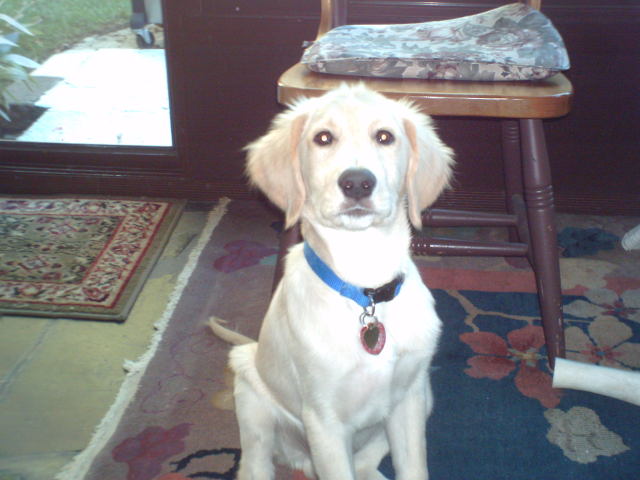 my 7 month old golden changed for the worse
QuestionRiley at 6 months
QUESTION: I got a gold
my 7 month old golden changed for the worse
QuestionRiley at 6 months
QUESTION: I got a gold
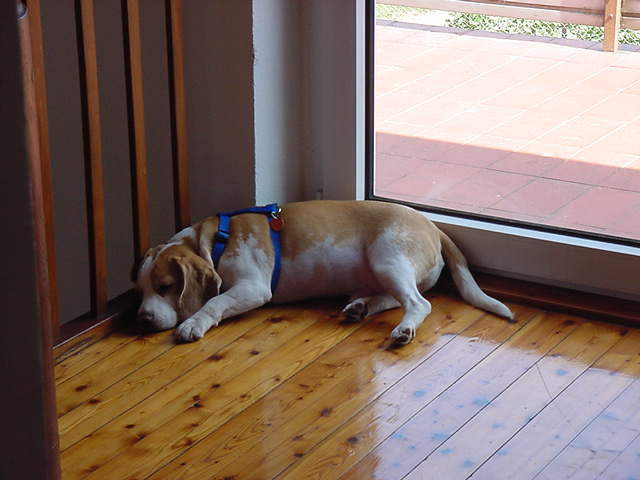 licking the floor not stop
QuestionGeorgie
QUESTION: Hi,
I have a 7 year ol
licking the floor not stop
QuestionGeorgie
QUESTION: Hi,
I have a 7 year ol
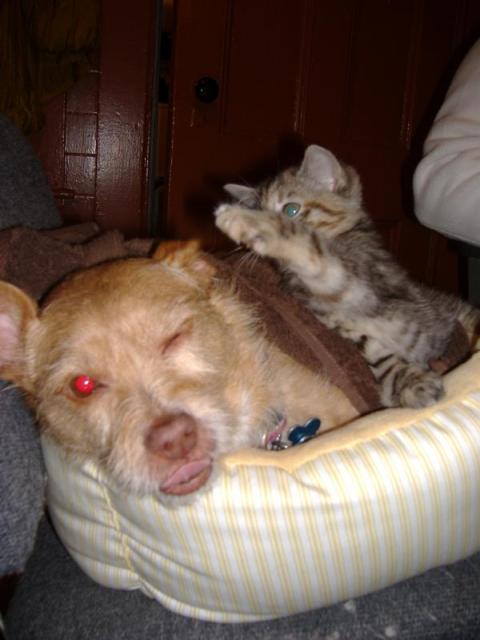 My dog is shaking and hiding under my bed recently
QuestionRorrie and Pencil
QUESTION: My dog, Rorr
My dog is shaking and hiding under my bed recently
QuestionRorrie and Pencil
QUESTION: My dog, Rorr
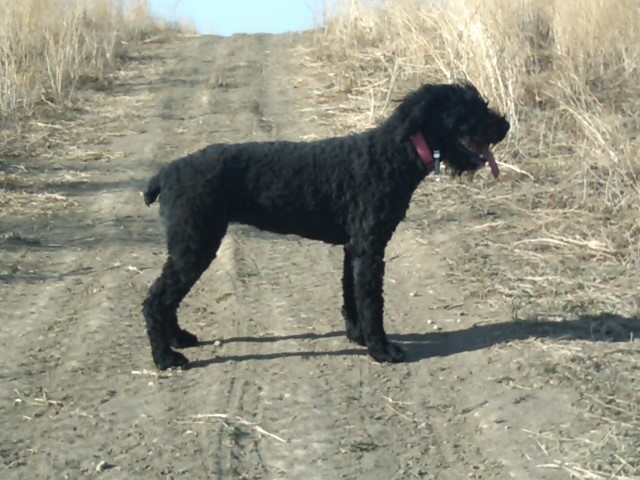 I was riding my bicycle when my 1yr old Bouvier bit my leg
Question
Pup
Hello, I have a 1yr old intact Bouvier bit
I was riding my bicycle when my 1yr old Bouvier bit my leg
Question
Pup
Hello, I have a 1yr old intact Bouvier bit
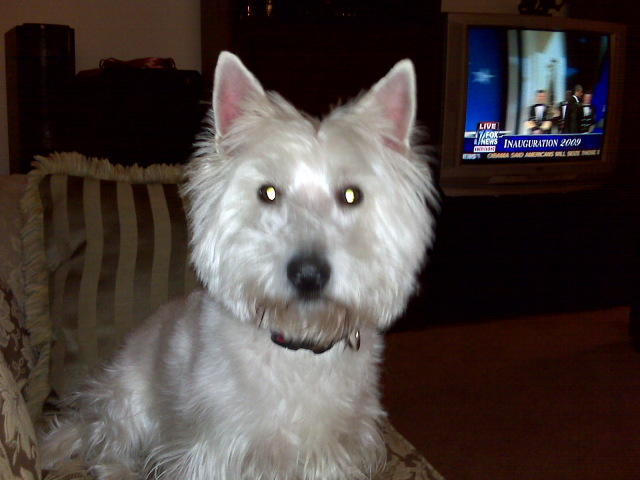 Companion for Lonley Westie
Question
Shannon
We have a 5-year-old neutered Westie w
Companion for Lonley Westie
Question
Shannon
We have a 5-year-old neutered Westie w